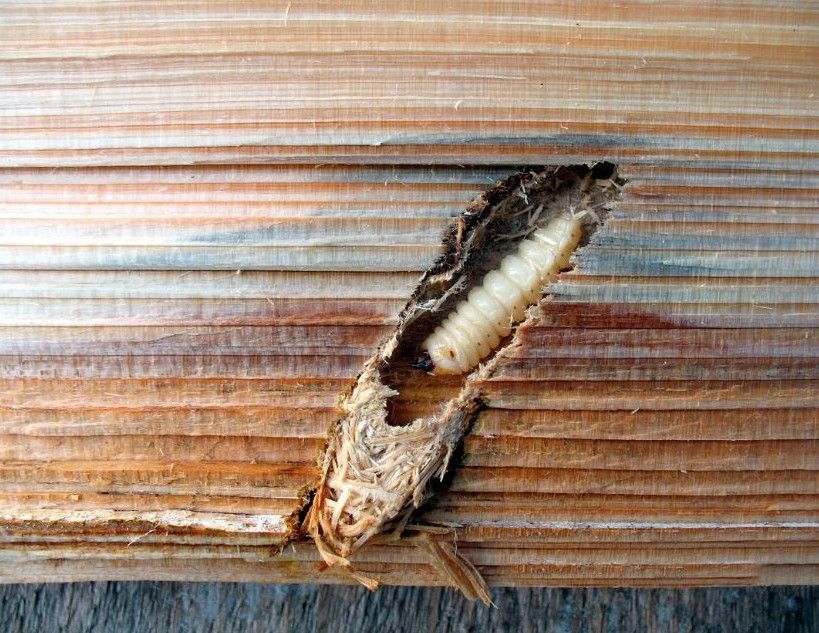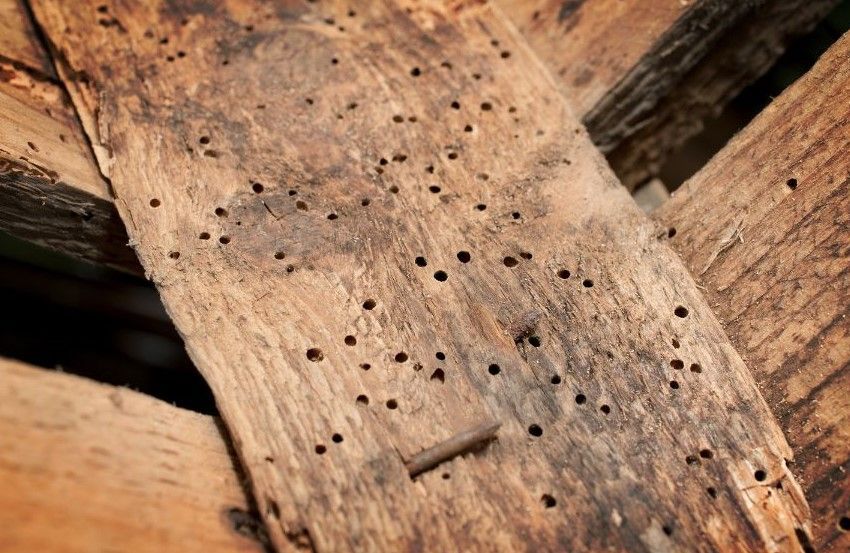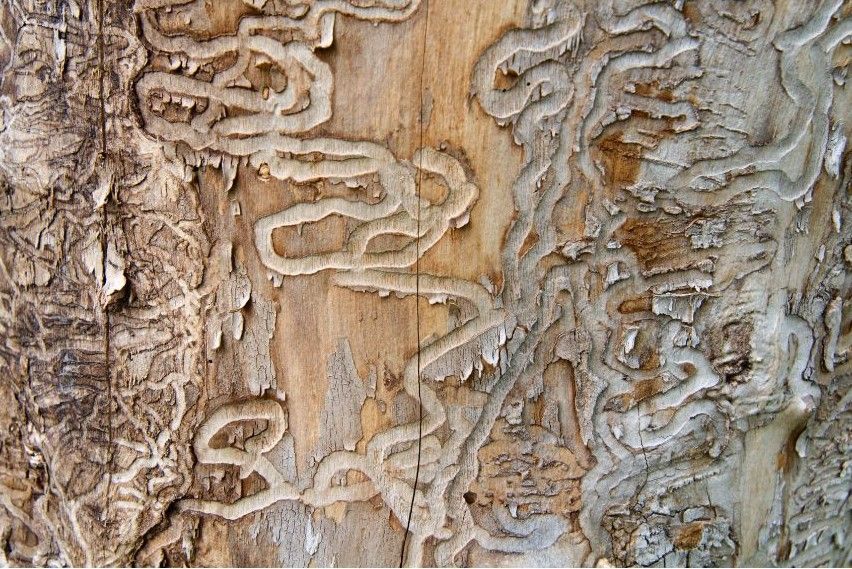Flatheaded Borers
Are you seeing sawdust around your trees?
If you are seeing small piles of sawdust around your trees, it could be a borer eating its way through the phloem of the tree. This puts the tree at risk for other pests, disease and even death. Continue reading to learn more about this invasive species.
What are Flatheaded Borers & why are they a nuisance?
Flatheaded borers are beetle larvae that tunnel just under the bark of tree trunks, branches, and roots. They excavate shallow, winding tunnels through the tree phloem and outer sapwood. Evidence of flatheaded borer infestation is a series of sawdust-filled galleries on the inside of loose bark pulled from injured, dying, or dead trees. With their small size and slight appearance, it’s hard to believe that flatheaded borers can take on a tree of massive proportions. Interestingly, it’s the larvae that are most damaging since they feed within the vascular layer that is underneath the bark. What this does is cut off the supply of water and nutrients to the tree, and branches and twigs begin to die and fall off. If the infestation is severe enough, it can cause the tree to die. What makes flatheaded borers an even bigger threat is that by the time the signs of damage are noticed, it’s often too late.



What do Flatheaded Borers look like?
Flatheaded borer larvae are up to 1 inch in length, white, deeply segmented, and legless. There is a prominent flattened enlargement of the otherwise-slender body just behind the head.
How can you tell if you have Flatheaded Borers?
You might spot adult borers on the sunny sides of your tree trunks in the summertime. Unfortunately, the adults are not always easily visible, even on badly infested trees.
To identify a borer infestation, inspect the trunk and branches for common symptoms. Signs of a potential pest infestation include the following:
- Cracked, peeling, or splitting bark
- Sap oozing from the trunk or lower limb wounds
- Bark areas that are lumpy, spongy, or sunken
- Sawdust-like material under flaking bark
- Oval or D-shaped holes left by adult borers exiting the tree
Is there help for infected trees with Flatheaded Borers?
If you notice that branches and twigs are dying and the bark can be easily pulled off, it’s time to have an arborist make a proper diagnosis and make recommendations for treatment.
What are the recommended treatments for Flatheaded Borers?
First using a contact insecticide such as Sylo Insecticide to the tree trunk, limbs, and bark to kill any active borers that are inside the tree. Sylo Insecticide is a synthetic pyrethroid insecticide that contains the active ingredient Cypermethrin and serves as a good contact insecticide that can prevent infestation of tree borers to infested trees and shrubs. Timing is crucial as it is best to treat trees early on in an infestation to attack the newly hatched tree borer larvae before they begin tunneling into the bark.
Once the active borers have been killed off, apply Dominion 2L via soil treatment around the tree for continued protection against tree borer damage and reducing the likelihood of future infestations. Dominion 2L is a systemic insecticide meaning that it when applied to the soil, it will be taken up into the tree roots and help to control any tree borer pest that tries to burrow or feast on the tree.
Are there any organic treatments for Flatheaded Borers?
Garlic and nasturtiums are supposed to help with fruit trees. Simply plant cloves of garlic around your fruit trees, which will help prevent visits from the adult borer beetles.
Nasturtiums, which are well-known for their ability to keep damaging insects away from vegetable gardens. Growing nasturtiums is very easy. Just plant some seeds underneath your fruit trees and they will begin to grow in spring. Because nasturtiums are annuals, they will die, but will leave seeds behind that will come up again the following year.
What happens if the tree is heavily infested with Flatheaded Borers?
Sometimes, trees become infested by borers despite the best efforts of the owner. Trees that are heavily infested should be removed and burned so that developing borers do not complete their life cycles. All branches and debris from the tree should be removed. New trees and plants should not be planted close to the site of infestation and keeping the base of the tree exposed will make it easier to spot flatheaded borers early on and stop the infestation. By caring for your trees and keeping them healthy and strong from the beginning, you can greatly decrease the chances of the trees becoming infested from borers.
Can Flatheaded Borers be prevented?
Most flathead borer infestations can be prevented with the help of a certified arborist and professional tree services as well as a few hands-on practices. Prevention is the best form of management, and it will go a long way in protecting trees. Treat any infestations immediately. The best approach is to keep the trees healthy. When trees are healthy, they are not as vulnerable to attack. Actions that promote tree health include:
- Site and species selection, it’s important to consider when selecting trees and shrubs, their susceptibility to insect and diseases
- Proper planting to minimize tree stress, providing suitable water and nutrients
- Fertilizers to correct nutrient deficiencies and active defense against injury (lawn mowers, trimmers, root disruption, etc.). Any damage is an open invitation for flatheaded borers.
- Place mulch, supplemental water, and fertilizers around the tree at times it helps in preventing the tree borers from causing harm to the tree. This will help in controlling the damage being caused by borers. Use proper organic compost and fertilizers that are nitrogen-free. Clean up all the debris.
- Eliminate sources of beetles by pruning and removing dead and dying limbs and trees. It is best to cut off the branches and nearby mulches, grass, and cut all the unwanted decayed leaves and branches as short and trim as possible. It will make it unappealing and more difficult for the tree borers to infest a trimmed tree.
References:
How to Manage Flatheaded Borers - Growing Earth Trees
Flatheaded Borers | Horticulture and Home Pest News (iastate.edu)
Tree Insect Control To Combat The Flathead Borer | Reliable Tree Care
Flatheaded Borer in pennsylvania - Search (bing.com)
Types of Flatheaded Borer - Search (bing.com)
www.tnstate.edu/extension/documents/Flatheaded%20Borer%20Management%…
Pacific and Appletree Flatheaded Borers | USU
Growing Fruit Trees: How to Repel Borers Naturally - Birds and Blooms
Images - Canva
Check out the latest:









